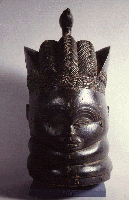
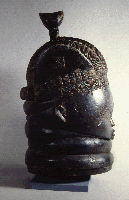
This mask is worn over the head of a female elder who dances for the Sande women's society. The mask displays and celebrates Mende ideals of female beauty and virtue: elaborately braided hair (cosmetic skills, sexuality); neck creases (full-bodied, good health); smooth, broad forehead (nobility, intelligence); lowered eyes (contemplativeness, restraint); well shaped ears; small nose; small mouth (not given to gossip); composed expression (inner serenity), smooth skin (youthfulness). All these features are exaggerated in the mask, its three thick rows of braided hair, large neck folds, wide forehead, diminutive nose and mouth, and polished surface. The bird figure (missing its head & tail) perched on top of the coiffure has many meanings: clairvoyance, love, fertility, power, danger, discipline, prudence, and laughter. The mask's shining blackness connotes the essence of female beauty and moral purity.
Gift of Mr. and Mrs. Peter Klaus, 1981.43.1
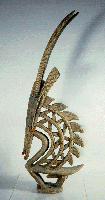
To the Bamana people, farming is the most important and noblest profession. At planting time, men of the Chi-Wara association of farmers dance with headresses like these in the fields to honor Chi- Wara, the mythical "farming animal" that taught agriculture to the ancestors of the Bamana. The headdresses, always danced in male and female pairs, depict the antelope-like Chi-Wara and display the ingredients of successful cultivation. The long horns of the male Chi Wara stand for the tall growth of millet; the penis signifies the rooting of this grain. The long ears refer to the cultivators' listening to the songs sung by women who encourage the men while they work in the fields; the open, zigzag pattern in the neck symbolizes the sun's path along the horizon between the two solstices.
Gift of Mr. and Mrs. Edward G. Lanpher, 1979.40.l

The "female" Chi-Wara headdress, representing the earth, always accompanies the male headdress during the harvest dances. The baby carried by the female symbolizes baby human beings. As in the male Chi-Wara headdress, the long horns stand for the desired growth of tall millet. The element of water is represented by the fiber costume attached to the headdress. When danced by a pair of men chosen as exemplary farmers, the headdresses symbolically combine those elements necessary for good agriculture: sun, water, and a solid rooting of the plant in the earth.
Anonymous Gift, 1979.44.14
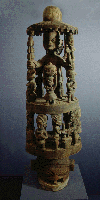
The annual Epa festival celebrates the important social roles of a town: its chiefs, farmers, warriors, hunters, priests, and women. The climax of the festival occurs when male dancers appear, surrounded by their followers and wearing tall, heavy masks like this one, receiving salutations, praise names, and songs. The lower, abstract helmet portion conceals the dancer's face and allows him to see through the mouth. The upper, more naturalistically carved, superstructure celebrates the central figure at the top, the herbalist priest (Osanyin) who wears a fringed hat. In his right hand the priest holds his official staff, identified by a cock surmounting several tiers of clustered bells. Below the staff is a pot drummer. In his left hand he holds a staff showing two musicians, a kneeling flutist on top and a dundun drummer below. Along with the pot drummer, the kneeling flutist and the dundun drummer herald the presence of the priest, the dundun drummer beating out tone patterns that sing the praises of the priest. A female "bowl carrier" stands before the priest. The bowl contains the herbal medicines, the power (ase), of the priest. In Yoruba iconography bowls contain hidden power and are thought of as possessing powers similar to those of women, associated with their powers of reproduction and ability to compromise the fertility of others. This is the hidden power of "our mothers," celebrated in the Gelede ceremonies and by the Gelede headdress shown in this exhibit. Since the welfare of the town depends upon the herbalist's skills of healing and controlling evil, he is accompanied by a retinue of spear bearers, flutists, horn players, men carrying gourds of his medicines, women pounding yams (a festive food), and a woman carrying a child, suggesting that the powers of the Osanyin priest assist in giving birth. This elaborate array of figures (all formerly painted with bright colors) shows the carver's powers of composition and mastery over the massive bulk of wood.
Gift of Bob Bronson, 1978.40.14
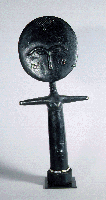

The akua'ba figure is supposed to induce pregnancy and ensure safe delivery of a beautiful, healthy infant. After being blessed by a priest, a woman carries the statuette around with her and treats it like a real child; she adorns it with beads and earrings, "nurses" it, and puts it to bed. The statuette illustrates Asante concepts of beauty: a high oval, flattened forehead (achieved by massaging the infant's soft skull); a small mouth; a neck ringed with creases of subcutaneous fat, indicating the good health of the infant. Most akua'ba figures depict females, since among the Asante the family line is passed down from the mother to the daughters.
Gift of Mr. and Mrs. Howard Cohen, 1983.38.1
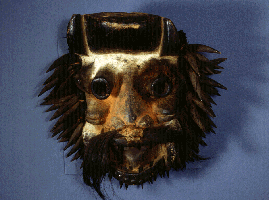
Wee masks embody spirits of the forest who request (through dreams) that masks be made so they can "appear" before the people. The Dan classify their masks into masculine and feminine types. The masculine mask, such as the bagle grotesque mask shown here, has square outlines, tubular eyes, and zoomorphic features. This mask is intended to look powerful and fearsome, with its animal horns, bulging forehead, tubular eyes, gaping and toothy mouth, large beard, and mustache. The bagle masker dances vivid pantomimes that entertain the guests at festivities and often caricatures the events of the day.
Gift of Dona and Lee Bronson, 1978.46.16
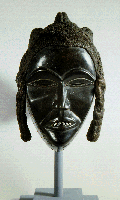
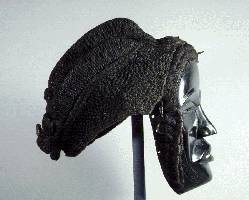
Dan masks embody spirits of the forest who request (through dreams) that masks be made so they can "appear" before the people. The Dan classify their masks into two types, masculine and feminine. The feminine type of mask, such as the Tankagle shown here, has an oval face and narrow slit-eyes. This type of mask performs at village festivals and entertains the public with exquisite dancing, singing, and pantominic sketches.
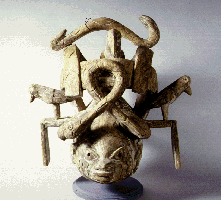
The annual Gelede festival honors the creative and dangerous powers of women elders, female ancestors, and goddesses, known affectionately as "our mothers." The Gelede headdress often consists of two parts, a lower mask and an upper superstructure. The lower mask depicts a woman's face, its composure expressing the qualities of calmness, patience, and "coolness" desired in women. The static expression and simplicity of this portion of the headdress contrasts with vitality and diversity of the superstructure. The design of the superstructure is intended to placate the mothers by displaying their inner powers for all to see, thus pleasing them and ensuring the well-being of the community. Birds signify the dangerous noctural powers of women who act as witches. Snakes symbolize the positive feminine qualities of patience and coolness. The snake coiled around the front also cautions vigilance with the saying "the snake sleeps but continues to see." Gelede artists demonstrate their artistry and mastery of the medium by developing complex imagery within the confines of the basic cylindrical mass of wood. The elaborately carved example shown here (originally painted in bright colors) exhibits many different forms and angles to view, as the dancer moves before his admiring audience.
Gift of Mr. and Mrs. Martin J. Tauger, 1979.58.9
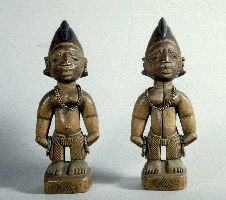
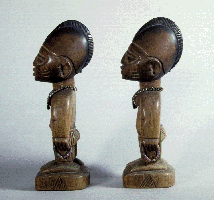
Among the Yoruba, twins (ibeji) are special children whose birth can bless their parents with good fortune. The Yoruba have one of the highest rates of twin births in the world, and the loss of twins is therefore considered a great misfortune. If a twin dies, the mother commissions a memorial figure (two if both twins die), and the soul of the deceased twin is transferred to it. The mother dresses the statuette in cloth and adorns it with jewelry, and keeps it near her bed. She also offers it food and prayers weekly and performs more elaborate rituals on the occasion of birthdays and annual festivals. The figures are carved according to different regional styles; those shown here are made according to the Abeokuta style. The statuettes conform to the Yoruba aesthetics of physical proportion. The head is one third the size of the body, because the head is associated with a person's destiny or "inner head," which determines success and failure in life. Artistic emphasis is placed on "human resemblance," rather than photographic likeness, and the facial features, though stylized, are carefully deliniated and delicate. The smoothed surface, which is difficult to achieve without sandpaper, expresses the desired quality of luminosity. Other Yoruba aesthetic qualities are relative straightness, good composition, youthful appearance, and clarity of line.
Lent by Benjamin Ray
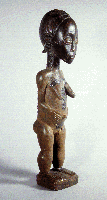
The Baule believe that before people are born into this world they have a spouse in the other world, and that these spouses occasionally become angry or jealous and disturb the lives of their living partners. When this happens, a diviner recommends that an altar be established where the spirit may receive offerings and be appeased. The carved figure of the "spirit spouse" should be beautiful in order to please the spirit and attract it to the shrine. The female "spirit spouse" figure shown here expresses Baule ideas of physical beauty and moral virtue. The erect bearing indicates a morally upright person; the open eyes and high forehead suggest intelligence and lucidity. The hands held obediently at the sides and the modest stance of the feet give the figure a respectful attitude that shows good character. Physical perfection is shown in the healthy body, the strong neck able to bear heavy loads on the head,and the muscular calves of the hard worker. The pointed breasts and rounded buttocks signify maturity and sexual attractiveness, and thus the promise of children.
Gift of Dona and Lee Bronson, 1978.46.18
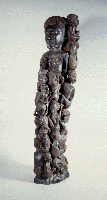
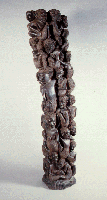
A modern style of sculpture made for the European export market, this piece depicts a "tree of life" motif: the members of an extended family, including past and present generations, gently supporting each other, generation after generation, around the family ancestor. The naturalism of the human figures, the sculpture's polished finish, and the choice of wood (ebony) were originally dictated by the European tourist trade of the 1950s. The artistic unity, imagination, and delicate detail of the piece on display all indicate its high quality. Although thoroughly modern in style, without any known basis in traditional Makonde art, the subject matter of this sculpture is entirely indigenous.
Gift of Mrs. Nancy Gray, 1981.94.75
"Nobody likes to live without beautiful things," replied a Guro weaver when asked why he hung a decoratively carved pulley on his wooden post loom set up beneath a mango tree. The decorative features of West African heddle pulleys -- devices that hold the heddles in looms -- are created solely for aesthetic satisfaction, and have no ritual or magical purpose. The delicately carved figure on the pulley peers down at the weaver as he works and becomes his constant visual companion. The formal composition of these small pieces shows great virtuosity and variation: the artists strive for originality, ingenuity, elegance, and imaginative effects.

The Senufo refer to the hornbill as the "master among the birds" because of its sexuality (phallus-like beak) and intelligence. "Master," as a title in the men's Poro society, connotes intelligence, creativity, and mastery of a particular skill, such as weaving. The shape of the bird shown here is abstract and imaginative; it also shows the delicacy, smoothness of finish, and skillful composition that are prized by African carvers.
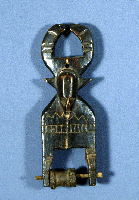
Naturalistic faces occur rarely on pulleys. Senufo artists draw upon a wide repertoire of facial styles that appear on statues for spirits and masks. The large eyed face on this pulley is that of the friendly Tugubele spirits of the forest.
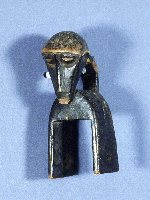
The face on this pulley portrays a buffalo mask as it appears on a dancer in the men's Poro age-grade society. The buffalo motif symbolizes advancement and regeneration in the Poro society, the path that leads to adulthood and social fulfillment.
Click here to consult the bibliography.
Click here to return to the title page.